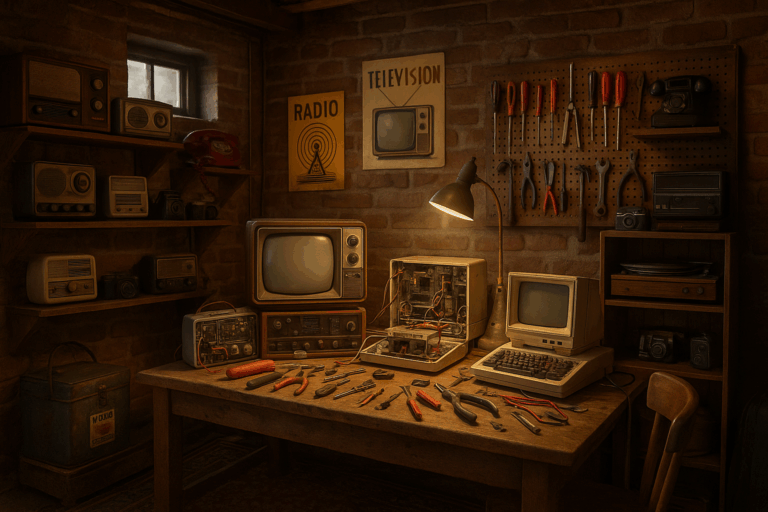a
The lure of retro items lies not only in their inherent charm but also their potential value, both sentimental and financial. However, these timeless treasures are often susceptible to damage, degradation, and decay if not stored properly. But fear not, for this article is designed to serve as your comprehensive guide to avoiding common storage blunders, ensuring your collection’s longevity, and keeping it in pristine condition. Whether you’re a novice collector just starting on this exciting journey or a seasoned curator with years of experience under your belt, there’s always room to learn, improve, and adapt.

In the ensuing sections, we will delve deep into the intricacies of handling and storing different types of retro items, ranging from paper-based collectibles like comic books and posters to more robust ones like vinyl records and vintage gadgets. We will also discuss the various factors that could potentially damage your collection, such as environmental conditions, improper handling, and inadequate storage solutions. This knowledge will arm you with the tools needed to build your personal vault — a safe haven where your retro collection can flourish and stand the test of time.
But before we journey further down this rabbit hole, let us take a moment to appreciate the beauty and significance of retro collections. Each item, each artifact, tells a story — a story of the era it originated from, the hands it passed through, and the journey it undertook to become a part of your collection. Through this article, you’re not only learning to preserve these stories for generations to come but also ensuring their narratives continue to enchant, educate, and entertain. So, without further ado, let’s unlock the vault and dive into the fascinating world of retro collection storage!
Understand the Importance of Proper Storage
Before diving into the common mistakes, it is crucial to understand the importance of proper storage for your retro collection. Retro items, be it video games, comic books, or vinyl records, hold more than just monetary value. They are historical artifacts, encapsulating a particular time and place, and they need to be preserved accordingly.
Improper storage can lead to a myriad of issues, including physical damage and degradation, which can significantly decrease their value and longevity. If you are a collector who cherishes their retro items, you want to ensure they are stored in conditions that will maintain their quality for years to come.
But despite the best intentions, many collectors unknowingly make mistakes when storing their retro items. These mistakes can hasten the degradation process and ultimately lead to the loss of these treasured items. To avoid these pitfalls, it is essential to educate oneself on the best storage practices and understand what not to do. This article will delve into these common mistakes and provide practical solutions to help you properly store your retro collection.
Common Storage Mistakes
Mistake #1: Storing in Inadequate Conditions
One of the most common mistakes is storing retro items in inadequate conditions. This includes areas with high humidity, extreme temperatures, or direct sunlight, which can cause items to warp, fade, or even mold. These conditions can cause irreversible damage and significantly reduce the lifespan and value of your items.
To avoid this, store your items in a cool, dry place away from direct sunlight. You can use a dehumidifier to control the humidity level and store your items in a temperature-controlled room. Remember, the ideal storage conditions can vary depending on the type of item, so do your research to understand the best conditions for your specific collection.
Mistake #2: Storing Without Proper Protection
Another common mistake is storing items without proper protection. This can include not using protective cases or bags, stacking items improperly, or storing items loose without any form of protection. These practices can lead to scratches, tears, and other physical damage that can negatively affect your items.
Invest in proper storage materials, such as acid-free bags, sturdy boxes, and protective cases. Also, avoid stacking items to prevent damage from weight and pressure. Remember, each item in your collection is unique and deserves to be stored with care.
Comparison of Storage Conditions
Storage ConditionEffects on Retro ItemsHigh HumidityCan cause items to warp or develop mold.Extreme TemperaturesCan cause items to become brittle or discolored.Direct SunlightCan cause items to fade or become discolored.Improper ProtectionCan cause scratches, tears, or other physical damage.
For a visual guide on how to properly store your retro items, check out the video “Proper Storage for Retro Collections” by the YouTube channel “Retro Collecting 101”.
Avoiding Mistakes: Best Storage Practices
Now that we’ve discussed the common mistakes, let’s delve into the best storage practices for your retro collection. It’s crucial to note that these are not one-size-fits-all solutions. Each type of item, whether it’s video games, comic books, or vinyl records, has specific storage requirements that you need to consider. However, these general principles will provide a good foundation for you to start on.
1. Use Acid-Free Storage Materials: This is crucial, especially for paper-based items like comic books and posters. Acid-free materials prevent the items from yellowing and deteriorating over time.
2. Maintain Consistent Temperature and Humidity: Extreme fluctuations in temperature and humidity can cause significant damage. The ideal conditions will depend on the type of item, but generally, a temperature between 65-70°F (18-21°C) and a relative humidity of around 40-50% is recommended.
3. Store in a Dark Place: Direct sunlight can cause fading and discoloration. Store your items in a dark place or use UV protective covers for added protection.
Storage Tips for Different Types of Retro Collections
- Video Games: Use protective cases for game cartridges and discs. Store them upright and avoid stacking to prevent pressure damage.
- Comic Books: Use acid-free bags and boards for individual comics. Store them upright in a sturdy box and avoid overpacking to prevent spine stress.
- Vinyl Records: Use protective sleeves for individual records. Store them vertically and avoid leaning to prevent warping.
For more in-depth advice, I highly recommend watching the video “Preserving Your Retro Collection” by the YouTube channel “The Retro Future”.
Investing in Proper Storage is Worth It
Proper storage for your retro collection might seem like a daunting task, but the effort is worth it. By avoiding these common mistakes and implementing best storage practices, you can preserve your items’ quality, maintain their value, and ensure they can be enjoyed for many more years to come.

Remember, the goal is not just to store your items, but to preserve them. Each item in your retro collection tells a story, encapsulates a piece of history, and brings joy. And by investing in proper storage, you’re investing in the preservation of these stories, history, and joy.
So, take a moment to review your storage methods, identify any potential mistakes, and make the necessary adjustments. Your retro collection is worth it.
Additional Resources
If you’re interested in learning more about proper storage practices for retro items, here are some helpful resources:
- Book: “The Collector’s Guide to Storing Your Collection” by E. D. Monn.
- Video: “Retro Game Storage Solutions” by the YouTube channel “My Life in Gaming”.
- Online Forum: “The Retro Collection Storage Thread” on Reddit’s r/retrogaming.
These resources provide a wealth of information and practical tips to help you store your collection properly and avoid common mistakes.
Conclusion
In conclusion, we can ascertain that the world of information technology and engineering is constantly evolving. As technology continues to advance, it is integral to adapt and enhance our knowledge base, always keeping an eye out for the emerging trends and tools.
Throughout this article, we have delved deep into the intricacies of complex technical concepts, from the principles of software engineering to the nuances of technical writing in IT. These concepts, although complex, are the foundation of the larger picture – they build the world as we know it.
The importance of technical writing, as discussed, cannot be overstated. It serves as the bridge between the technical expert and the end-user, making the complex comprehensible. As our discussion has shown, mastering this skill can dramatically enhance the effectiveness of communication within and outside a professional setting. While the technique may be challenging, it’s clear that the benefits it brings, from clarity in documentation to enhanced understanding, make the endeavor worthwhile.
On the other hand, the realm of software engineering presents its own set of challenges and rewards. Understanding the principles and methodologies of software engineering is instrumental to creating efficient and robust software systems. As we’ve seen, these principles form the backbone of our digital world and their understanding allows for the creation of more reliable and efficient software solutions.
This article has been a journey of exploration and learning. We hope that it has been informative, and most importantly, that it has sparked a curiosity to delve deeper into these fascinating topics. It is through such inquisitive pursuits that we continue to grow and learn, pushing the boundaries of what is possible.
In the age of digital information, sharing knowledge is more accessible than ever. If you found this article insightful, please feel free to share it with your colleagues or friends who may also find it useful. Your comments and thoughts on the topic are also welcomed, as they help foster a more diverse and rich discussion.
For those of you who are inspired to delve deeper into these subjects, here are a few sources that I have found to be extremely informative and insightful: [Insert active links here]. Each of these sources presents a wealth of knowledge, offering different perspectives on these topics.
Remember, as Michelangelo said, “The greater danger for most of us lies not in setting our aim too high and falling short; but in setting our aim too low, and achieving our mark.” So aim high, keep learning, keep growing, and keep pushing the boundaries of what is possible.
Thank you for taking the time to read this article. Your engagement is what makes this journey of knowledge sharing worthwhile. Until next time, happy learning!



